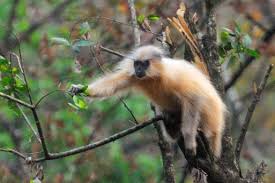 The Golden Langur resides in Manas Wildlife
Sanctuary, India and in the low elevation
forests of Bhutan.
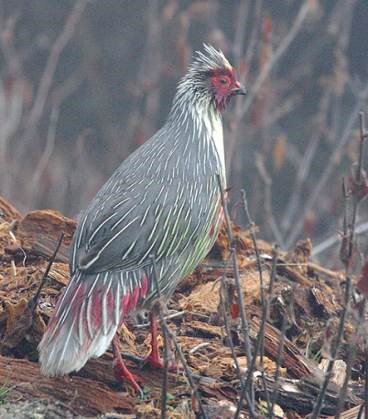
A Blood Pheasant, among a number of
Himalayan pheasants in Bhutan.
Photo credit: H. Tsering
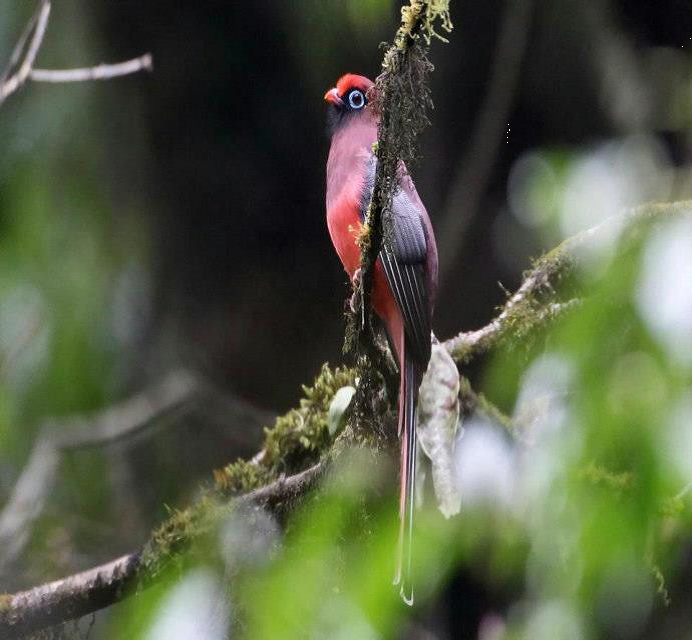
Watch for this Ward's Trogan,
one of Bhutan's rarest birds.
Photo credit: H. Tsering
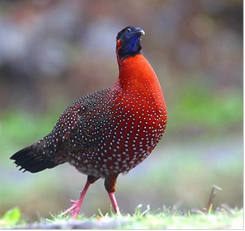
The stunning Satyr Tragopan.
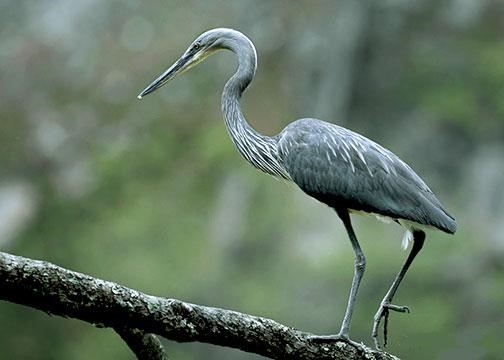
White-belled Heron: though rare, you'll
have a good chance to see them riverside.
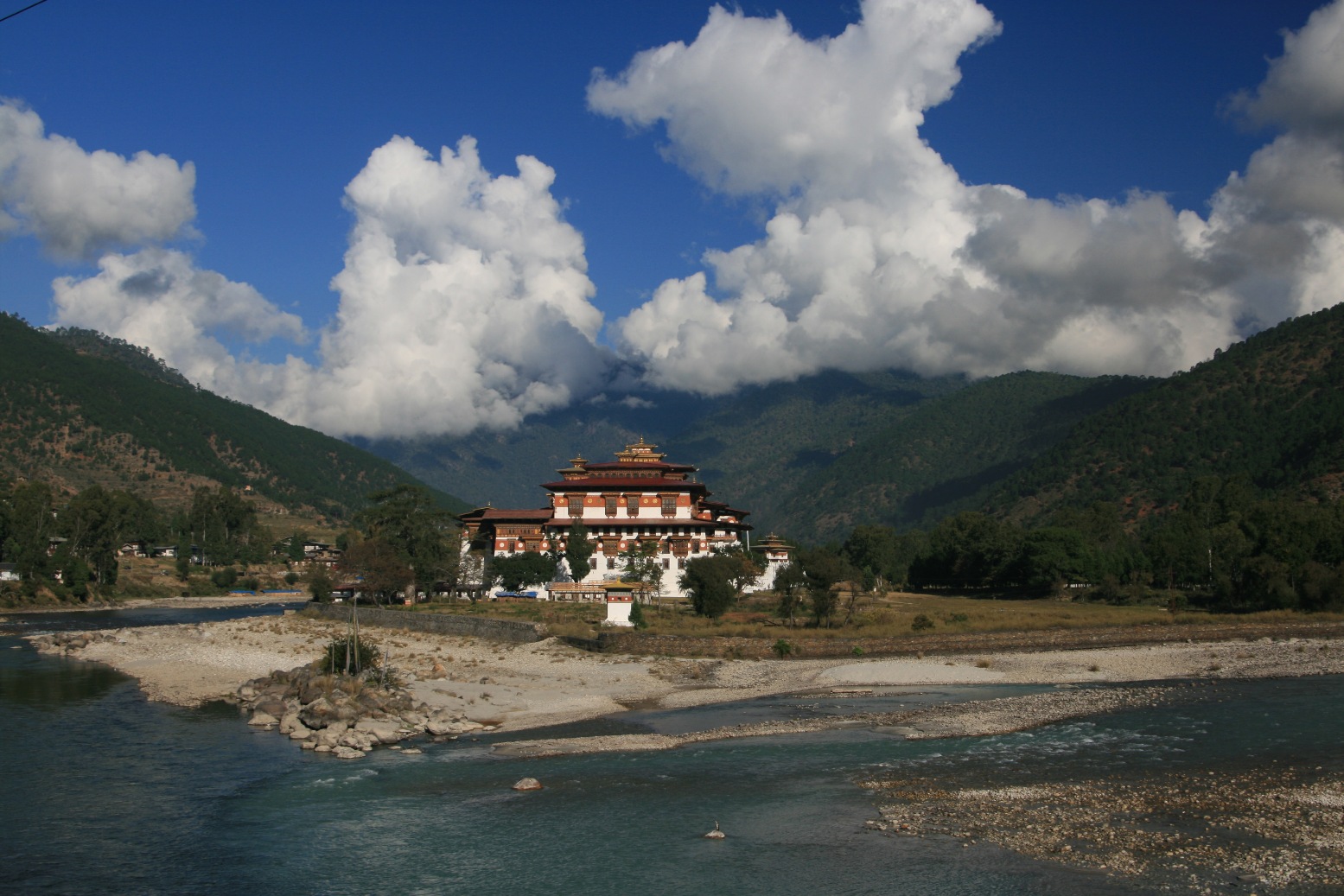
Punakha Dzong: built in the 17th century.
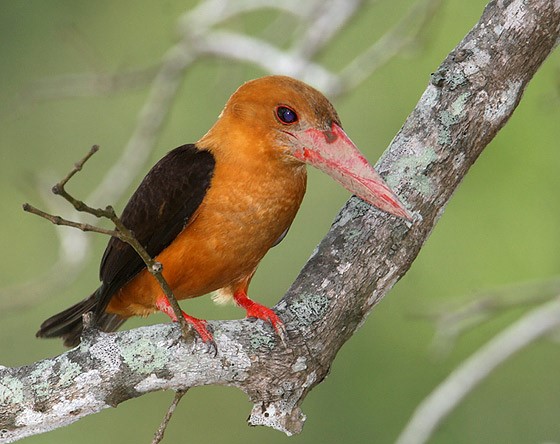
A Brown-winged Kingfisher
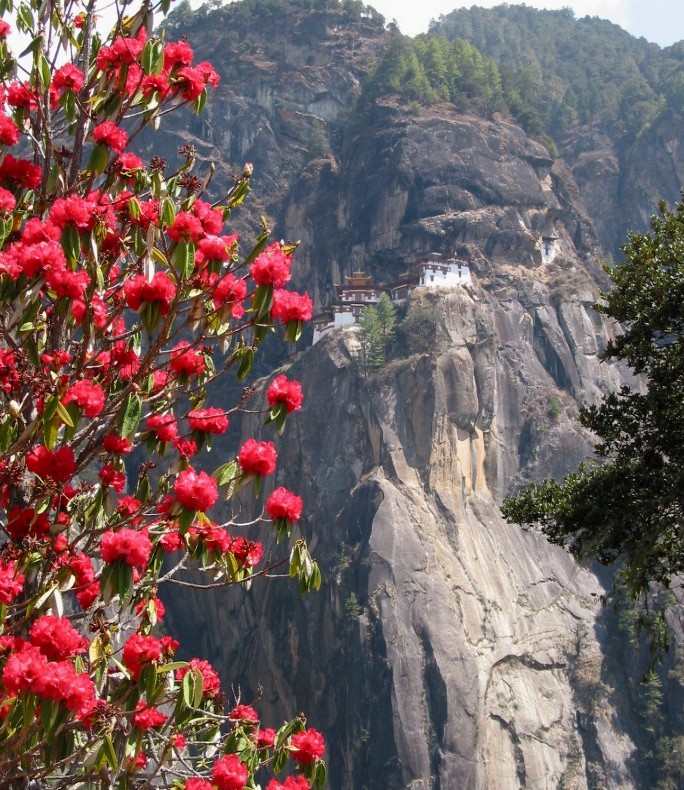
Taktsang monastery, high above Paro Valley,
framed by rhododendron trees in spring.
|
Cost includes:
- 12 nights in India and Bhutan,
staying in lodges, guest houses, and
3-4 star hotels, double occupancy
- All meals in India and Bhutan
- Guided by an English-speaking birding and wildlife naturalist
- Private vehicle with driver
- All activities and entry fees
as per the itinerary
- Drinking water
- Bhutan visa fee
Cost does not include:
- International flight airfare
- Flight to Guwahati
- Hotel overnight and meal charges en route
- Beverages except drinking water
- India visa fees
- Optional activities
- Tips for guide, driver and service staff
- Expenses of personal nature
- Trip cancellation insurance
- Emergency evacuation insurance (required)
- Services not mentioned above
- Recommended donation of $250 to Royal Society for Protection of Nature, Bhutan
Additional details provided in full itinerary.
|
|
It is more than geography that blesses Bhutan with an incredible wealth of nature and wildlife. The Buddhist philosophy, and leadership that values sustainable and equitable development, environmental conservation, cultural preservation, and good governance, guide the country down a middle path that makes space for all living beings.
Come see for yourself. Join this trip, designed especially for birdwatchers, wildlife spotters and nature lovers, spiced with cultural flavors and encounters with traditional ways of life. On a recent trip, well over 200 species of birds were sighted in just ten days. Remarkable!
Spring and fall are the best times to visit Bhutan. Spring offers the added attraction of blooming rhododendrons on bushes and trees that tower overhead, as well as an active time for viewing wild- and birdlife. Days are long and rains generally don’t begin until mid to end of May. Fall is also beautiful, and may allow you to take in a Buddhist ritual festival along the way.
Trip in Brief
You’ll begin the journey in the jungles of north Indian, where you’ll be on safari in Manas Wildlife Sanctuary, watching for wild elephant, royal Bengal tiger, greater one-horned rhino, clouded leopard, sloth bear, wild buffalo and more.
Then cross the border into Bhutan and immediately sense the peace and tranquility in contrast to the hustle and bustle of India. You’ll travel by private vehicle with a naturalist/birding guide for the next 10 days, through Bhutan’s mid-elevation hills to a high point of 12,000 feet, giving window to birdlife and wildlife in the forests and along stream-side at every turn.
From Bumthang, home to some of Bhutan’s most important Buddhist monasteries and pilgrimage sites, drive west to Punakha where you’ll spend a day on the look-out for the White-bellied Heron, a critically endangered bird.
You’ll have time in Thimphu and Paro to see several excellent museums of traditional arts and crafts, and to hike up to the famous Taktsang (Tiger’s Nest) monastery on the cliff above Paro Valley. Depart Paro and return to Delhi or Bangkok for your homeward bound flight.
This trip can be customized to fit your schedule and preferences. For a shorter duration, we’ll drop Manas Wildlife Sanctuary and begin at the Bhutanese border via Guwahati. If you’d rather stay entirely within Bhutan, you can begin and end in Paro with variations to the routing. You can add a visit to Phobjikha Valley to see the Black-necked Cranes in their wintering habitat – a threatened species that arrives in Bhutan from across the Himalaya in Tibet to much celebration in late October/early November.
In the words of a recent Bhutan traveler who has traveled widely on birding and wildlife viewing trips:
"Our guide was one of the best naturalists that I have ever had the privilege to accompany into the field… He knows all the birds and bird calls. He has excellent eyes and can spot birds (or hear them) from his seat at the front of the bus. He is an (also) accomplished botanist (and) knows the Latin names of the trees, shrubs and herbaceous plants. In addition, he knows the mammals of Bhutan. He is a snow leopard biologist. Beyond this, he is an excellent bird photographer and enjoyed taking time to help me become a better photographer. Dr. Satie Airame, April 2017
Itinerary
Days 1 - 2: Fly to Guwahati, jungle safari at Manas Wildlife Sanctuary. We’ll assist you in reaching Guwahati (via Delhi or another gateway city) where you’ll meet our Bhutanese naturalist guide who will be with you throughout the trip. Overnight in an eco-lodge, from where you’ll explore the riverside grasslands and tropical evergreen forests of Manas, a UNESCO Natural World Heritage site. The Sanctuary is considered to be a biodiversity hotspot and provides habitat for nearly 60 mammal species, 42 reptile species, 7 amphibians and 500 species of birds, of which 26 are globally threatened. Noteworthy among these are the elephant, tiger, greater one-horned rhino, clouded leopard, sloth bear, and other species such as wild buffalo, golden langur, and others.
Days 3 - 4: Drive to Trongsa.
Leaving India, you’ll cross the great Brahmaputra River before ascentding to 7,150 feet in one day. Imagine the changing landscape! You’ll stop frequently for birding along the way, and may catch a glimpse of the rare Golden Langur (photo left) in the trees. If time permits, you’ll visit Trongsa Dzong, the most spectacularly situated dzong (a monastery/fortress edifice) in all of Bhutan.
Days 5 - 7: In one of the best birding areas in the Asia-Pacific region! Traverse by car through pine forested valleys, cool broadleaved slopes and fir forested ridges from a few thousand feet in elevation up to 12,000 feet, stopping to enjoy the vistas and ever on the look-out for some of the stunning birds shown at left. Also watch for the wonderfully active and photogenic Capped Langur . The next day you’ll drive to Bumthang, Bhutan’s spiritual and cultural heartland. Keep your eyes open for coveys of Blood Pheasant (photo left). Overnight: Bumthang.
Days 8 – 9: Punakha. On a long day of driving and birdwatching along the East-West national highway. the vegetation changes at every turn, with inspiring views of old-growth forests and the Black Mountains in the distance. You’ll spend two nights in Punakha (4,428 feet), where one of the world’s 50 rarest birds – the White-bellied Heron is frequently sighted. After the next morning's birdwatching, you’ll visit Punakha Dzong (photo left), built in 1637 by a Tibetan saint that unified Bhutan in the 17th century. It is one of the finer examples of Bhutanese architecture. End the day with a late afternoon/early evening birdwatching session along the banks of the Mo Chhu. Aside from birds, there are also several different species of orchids along the trail.
Days 10 - 11: Thimphu. The drive to Thimphu is spectacular. The winding roads cut through mountains of dense and untouched forests, and the scenery is sublime. Stop at the high altitude pass of Dochu La (10,005 feet) where, if skies are clear, gorgeous views of the Eastern Himalaya unfold. Afterward, drive to Thimphu and visit the Takin Reserve to get a peek of Bhutan’s national animal – the Takin. Overnight in Thimphu (7,576 ft)
and spend the next day sightseeing in Thimphu. Drive to Paro in the afternoon, and if time permits, visit the National Museum of Bhutan. Overnight in Paro (7,478 ft).
Day 12: Excursion to Taktsang, the Tiger’s Nest No trip to Bhutan would be complete without a visit to Bhutan’s cultural icon – Taktsang. Spend your last hiking up to Bhutan’s most famous monastery and one of the most venerated pilgrimage sites in the Himalayan world. It perchs on the side of a cliff at an altitude of over 10,000 feet (photo left). Hear the legend of Taktsang from your guide, and join Bhutanese and visitors alike in experiencing this magical place. Return to Paro, and spend the afternoon at your leisure or exploring the small downtown. Overnight in Paro.
Day 13: Departure from Bhutan Fly to your transit or overnight destination (e.g., Bangkok or Delhi) before connecting to your homeward or onward bound flight. Details to follow.
Trip Cost: From $6,575/person
Additional single supplement charge applies.
Optional Extensions: Additional nights in Bhutan, e.g., to Phobjikha Valley to see the Black-necked Crane. You may also wish to spend extra nights in Thailand or India en route. We'd be happy to arrange your hotels and sightseeing tours. Please inquire regarding these and other extension options.
Top
For more information and a detailed itinerary... please contact
KarmaQuest Ecotourism and Adventure Travel
Tel: (650) 560-0101/
Fax: 712-8164
699 Spindrift Way, Half Moon Bay,
California 94019 USA
Karma@KarmaQuest.com
Website: www.KarmaQuests.com
|












